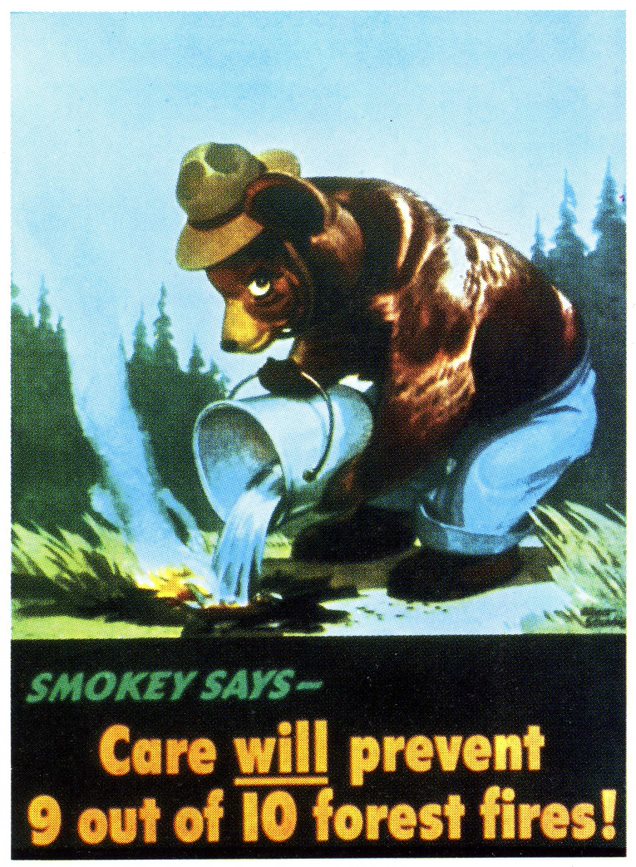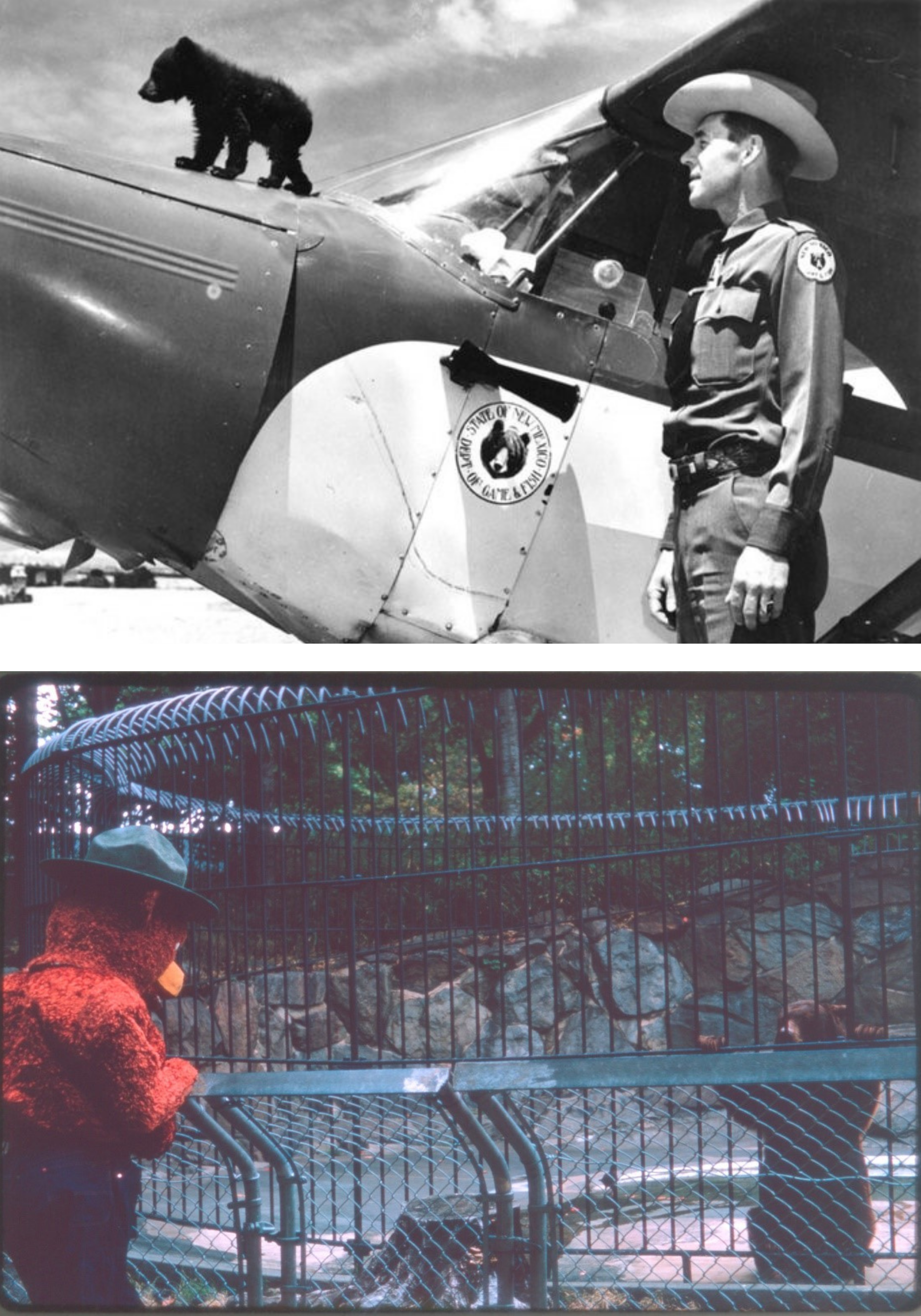By Grant Peterson
America’s favorite black bear turns 78 years old on Tuesday, August 9th.
There is a bear-y deep connection between the American people and Smokey Bear. Maybe it’s because Smokey’s “Only YOU” wildfire prevention slogan sticks in the brain like tree sap… or shall we say, “sticks like honey?” All puns aside, it takes a lot for a public service announcement campaign to be successful—especially one like Smokey’s, which coincidentally, is also the longest running PSA campaign in U.S. history.[1]
Smokey Bear and his signature catchphrase, “Only YOU can prevent wildfires!” are recognized by an impressive 96% of adults nationwide.[2] But how did we get to a point where Smokey Bear is one of the most recognizable figures in American history? And why do we still need Smokey and his message after 78 years?

Smokey’s origins can be traced all the way back to World War II. A few months after Japan attacked Pearl Harbor in 1941, Japanese ships fired shells on an oil field near the Los Padres National Forest.[3] Fortunately, damages were minimal; and while a wildfire didn’t break out, the incident did spark fears. With most of the nation’s experienced firefighters deployed in the war, the U.S. needed to devise a strategy to prevent as many unwanted, human-caused wildfires as possible.
Seeing this need, the USDA Forest Service organized the Cooperative Forest Fire Prevention (CFFP) program in 1942 with the Association of State Foresters (now the National Association of State Foresters) and the War Advertising Council (now Ad Council). Their original ads illustrated how forest fires could detract from the war effort, featuring slogans like, “Forest Fires Aid the Enemy” and “Our Carelessness, Their Secret Weapon.”
Just as the CFFP was created, Disney released the movie Bambi. The animated forest drama was a smash hit; and fortunately for the CFFP program, also showed how a forest fire started by human carelessness can have disastrous implications. The members of the CFFP committee saw an opportunity. The parties ultimately came to an agreement that authorized the use of Bambi’s likeness for a national forest fire prevention campaign for a two-year period. In 1944, with the need for a new prevention mascot imminent, the CFFP program decided to feature a different charismatic forest creature as the face of the campaign: a black bear.
The first Smokey Bear PSA produced featured his original catchphrase, “Care will prevent 9 out of 10 forest fires.” By 1947, the phrase was changed to the even catchier, “Only you can prevent forest fires.” In 2001, the phrase was updated again to, “Only you can prevent wildfires,” to clarify the distinction between unwanted, unplanned fires and intentionally set controlled burns.
Over the years, many artists have illustrated Smokey Bear, but the most influential is Rudy Wendelin. Wendelin served as Smokey’s full-time artist from 1944 to 1973. He was responsible for adding Smokey’s name to his hat and belt buckle, and for giving Smokey his signature blue jeans and shovel. Wendelin also made Smokey’s look less fearsome by changing his paws to hands and shortening his snout.

With Wendelin’s help, Smokey’s likeness graced posters, stamps, television programs, teaching materials, school lunch boxes, calendars, and films. In 1952, Congress passed the Smokey Bear Act, removing Smokey’s image from the public domain and putting it under the control of the Secretary of Agriculture.[4] Money made from royalties and licensing fees associated with the use of Smokey’s image continue to benefit wildfire prevention education efforts today.
The public truly fell in love with Smokey when he gained a real-life counterpart: a black bear cub who survived a wildfire in the Capitan Mountains of New Mexico. The cub’s rescue by wildland firefighters underscored the importance of keeping U.S. residents—human and non-human alike—safe from wildfires. Immediately upon taking up residence at the National Zoo in Washington, D.C., the living legend of Smokey Bear was a celebrity. In fact, the cub received so much mail at the zoo that the U.S. Postal Service assigned Smokey his own zip code (20252)—an honor bestowed to only one other individual: the president of the United States.
Woven into these letters are touching themes of compassion for animals, gratitude for wildland firefighters, pain and heartbreak, joy and love, and much more. One wholesome letter from a 6-year-old boy asks if Smokey could let him know when he eats his daily peanut butter sandwich so that the boy and his mother could visit him at the zoo and watch.[5] If the family made it to the zoo by the recommended time of 10:00 am on October 3rd, 1974, they would have seen Smokey devour his favorite salty snack.
Another Smokey fan sent a Christmas card with a gift of honey attached. Yet another letter expressed concern that the pool in Smokey’s zoo enclosure had been drained. Other pen pals thanked Smokey for his service, informed him of childhood aspirations to become a forest ranger, or expressed sympathy for Smokey’s mother who died in the forest fire that luckily spared him. Americans’ outpouring of support for the prevention legend proved just how lovable Smokey is.
When the living legend of Smokey Bear died in 1976, newspapers across the country published so many articles and obituaries that the National Zoo archives had to devote four times the regular amount of storage space to hold them.[6] Upon his death, he was buried near where he was found at the Smokey Bear Historical Park in Capitan, New Mexico. He was survived by his “wife,” Goldie, and his “adopted son,” Little Smokey.
Of course, the Smokey Bear campaign did not die in 1976. Smokey the icon turns 78 this year; and 78 more years from now, we will still face the threat of human-caused and unwanted wildfires. In fact, Smokey Bear and his message are more important than ever before.

In recent history, human activities have caused about 89% of wildfires each year in the U.S.[7] National statistics also show that almost all (97%) of the wildfires that threaten homes are human-caused.[8] With climate change exacerbating extreme weather and drought, and given the unhealthy conditions of many of America’s forests, catastrophic wildfires have become more common. Fortunately, it is possible to prevent most wildfires by practicing the “care” emphasized in the very first Smokey Bear poster.
Follow Smokey’s advice: don’t burn yard debris on windy days and always use spark arrestors on mechanical equipment. Never leave a campfire unattended, and make sure it is fully extinguished before leaving it unsupervised. Take responsibility and help protect our forests and communities from wildfires.
Even the small actions you take, like checking (or not checking) if your match is extinguished, can have unseen benefits or devastating impacts. Smokey Bear’s iconic phrase is a reminder that you do have control over some things—and sometimes, those things are the most important. Your actions have consequences, good or bad, so think before you act. Only YOU can prevent wildfires.
Grant Peterson is NASF’s policy and communications intern for summer 2022. He can be reached at intern@stateforesters.org. Have questions about NASF’s work with Smokey Bear? Contact NASF Communications Director Whitney Forman-Cook.

